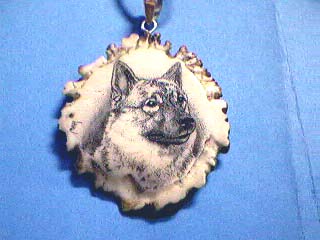![]()
Elkhound Legends

The Legend of How the
Norwegian Elkhound Got His Curled Tail
Tore
Ullin was a brave and skillful hunter. His generosity and goodness were well
know by all. His Elkhound, Bram, was always to be found by his side. The
midsummer dance on Myroid Mountain attracted young and old from all around. Food
and drink were plentiful at the festival and people danced and laughed
throughout. From Kvernbro Valley came Kransen. He was reviled and despised by
all who knew him. On the second day of the festival Kransen provoked a fight
with Tore. Kransen was killed by Tore. Unjustly, Tore became a hunted man. He
fled into the night with his Elkhound Bram to a distant, beautiful valley. Tore
and Bram hunted together and lived in caves in the mountains for years, escaping
the slain Kransen's vengeful clan. In the deep snow and frost Bram's tail often
became encrusted with ice and snow. It dragged behind him like a frozen broom
making hunting difficult. One day Tore took Bram's tail and tied it over his
back with a leather thong. From then on the Elkhound came to have its
distinctively curled tail.

The Legend of the Night of the Wolves
The
years from 1825 to 1845 are know in Norse folk tales as the Wolf Period. From
Finland and Sweden they came, hungry and vicious, hunting in packs, leaving the
stench of death in their wake. Neither game nor livestock were safe from these
ravenous hordes. In one valley alone, 15 horses were lost to the wolves.
Outlying farms were abandoned and no one risked venturing out in the night air
for fear of the wolves.
The
Elkhound was not merely the hunting partner of the men of the valleys. He was
the guardian of hearth and home. Even though armoured with a fearful spiked
collar of iron, many Elkhounds found their end, ripped apart and devoured by the
wolf invaders.
Wolf
night or Graabine as it was soon to become known occured on February 14, 1842.
The Elkhounds of the Norderhove valley were renowned for their skill and
fearlessness against the largest of moose. In this exalted company stood out
Fanarok the Fearless. Bravest of the Elkhounds in the valley. His young brother
Purven, the runt of the litter, was adored and protected by Fanarok. A terrible
fate would befall any who dared to injure Purven.
During
that night Fanarok was locked in the barn to protect the cattle from the wolves.
Somehow Purven had been left outside. Little time passed before the wolves
arrived. Spying the easy prey of a lone Elkhound the pack descended on Purven.
Inside the barn Fanarok could hear the ripping of fur and flesh as his beloved
little brother piteously called out to him. Frantically Fanarok clawed at the
door that separated him from his dying brother. Soon the cold night air became
still again. Little Purven was no more. When Fanarok was finally let out, all
that remained of his brother were small bits of fur and crimson stains in the
snow, illuminated by the brightness of the full moon. Fanarok let out a terrible
howl of grief for his dead brother and vengeance for those who had done this.
From farm to farm, throughout the valley the Elkhounds came to Fanarok's call.
Silhouetted
by the moonlight, Fanarok stood alone on frozen Lake Juveren. Eight of his
cohorts stood close by in the swamp waiting. Again with the vision of yet more
easy prey the wolves gathered. But this time things would be different. Darting
and dodging as he had many a time against the largest of moose, Fanarok broke
through the circling wolves. Not to be denied a fresh feast they gave chase. The
pack was led to the eight waiting Elkhounds. Even against the larger and more
numerous wolves Fanarok and his companions fought relentlessly and without fear.
The Elkhounds tore into the wolves, flashing teeth, ripping flesh from necks and
hind quarters. The wolves had met their match. The sounds of the battle alerted
the men of the village. They came with axes, guns and swords. Anything they
could use against these terrible foes. A settling of accounts was to be in order
for villager and Elkhound alike.
The
battle was joined. The smaller but more agile Elkhounds tore into the wolves.
Darting and weaving they maneuvered for an opportunity to strike. As fearsome
wounds were inflicted on the wolves their writhing bodies filled the air with
the smell of blood. More wolves arrived, attracted by the grim scent. Man and
dog stood side by side, as they had for millennia, working together against
their common foe. After an hour of this carnage the night invaders were
vanquished. The few left tried to escape but were dispatched by newly arriving
Elkhounds and villagers circling the frozen lake.
The
morning sun revealed the carcasses of 27 wolves. The wolf plague was over.
Purven has been avenged and the valley was peaceful and safe once again. The men
of the Norderhove valley would stay warm that winter in the coats of their foes.